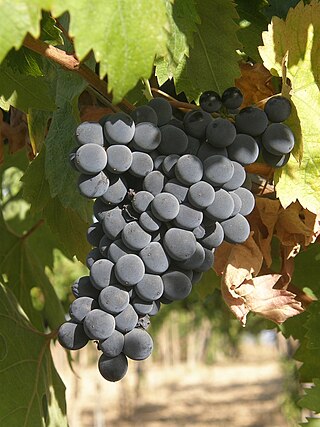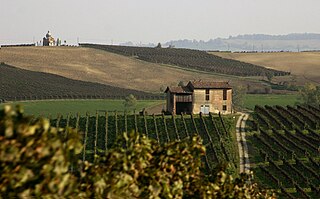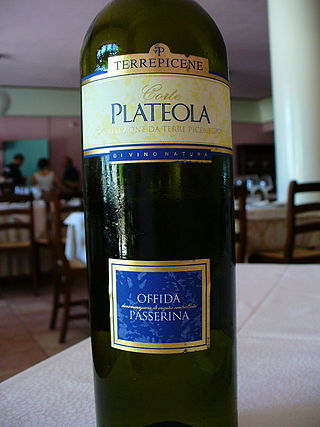This article relies largely or entirely on a single source .(January 2024) |
Falerio dei Colli Ascolani is a denominazione di origine controllata white wine made in the Italian region of Marche. The DOC was created in 1975.
This article relies largely or entirely on a single source .(January 2024) |
Falerio dei Colli Ascolani is a denominazione di origine controllata white wine made in the Italian region of Marche. The DOC was created in 1975.
The region lies on the eastern coast of Italy, encompassing the towns of Civitanova Marche, San Benedetto del Tronto and Ascoli Piceno. The wine region is one of the southernmost DOCs in the Marche. [1]
The name of the DOC can be traced back to Roman times, and is named after the ancient Roman city of Faleria, which is now the modern day commune of Falerone.
Falerio dei Colli Ascolani, like many wines of the Marche, is unique in its use of rare local Italian varietals that are seldom found anywhere else, here the Passerina and Pecorino grape varietals. The blend requires a minimum of 20% and a maximum of 50% Trebbiano Toscano, 10% to 30% Passerina, 10% to 30% Pecorino and up to 20% other white varietals. [1]

Verdicchio is a white Italian wine grape variety grown primarily in the Marche region of central Italy. The name Verdicchio derives from verde and refers to the slight green/yellow hue that wines made from the grape can have.

Italian wine is produced in every region of Italy. Italy is the world's largest wine producer, as well as the country with the widest variety of indigenous grapevine in the world, with an area of 702,000 hectares under vineyard cultivation, and contributing a 2013–2017 annual average of 48.3 million hl of wine. In 2018 Italy accounted for 19 per cent of global production, ahead of France and Spain. Italian wine is both exported around the world and popular domestically among Italians, who consume an average of 42 litres per capita, ranking fifth in world wine consumption.

Vin Santo is a style of Italian dessert wine. Traditional in Tuscany, these wines are often made from white grape varieties such as Trebbiano and Malvasia, though Sangiovese may be used to produce a rosé style known as "Occhio di Pernice" or eye of the partridge. The wines may also be described as straw wines since they are often produced by drying the freshly harvested grapes on straw mats in a warm and well ventilated area of the house. Though technically a dessert wine, a Vin Santo can vary in sweetness levels from bone dry to extremely sweet. While the style is believed to have originated in Tuscany, examples of Vin Santo can be found throughout Italy and it is an authorised style of wine for several denominazione di origine controllata (DOCs) and indicazione geografica tipica (IGTs).

Controguerra is a comune (municipality) in the province of Teramo, in the Italian region of Abruzzo.

Offida is a comune (municipality) in the province of Ascoli Piceno, in the Italian region of Marche, located about 80 km south of Ancona and about 12 km northeast of Ascoli Piceno, on a rocky spur between the valleys of the Tesino and Tronto (south) rivers. It is one of I Borghi più belli d'Italia.

Montepulciano is a red Italian wine grape variety that is most noted for being the primary grape behind the DOCG wines Colline Teramane Montepulciano d'Abruzzo and Offida Rosso; and the DOC wines Montepulciano d'Abruzzo, Rosso Conero, and Rosso Piceno Superiore.

Friuli-Venezia Giulia wine is wine made in the northeastern Italian region of Friuli-Venezia Giulia. There are 11 denominazione di origine controllata (DOC) and 3 denominazione di origine controllata e garantita (DOCG) in the Friuli-Venezia Giulia area. The region has 3 indicazione geografica tipica (IGT) designations Alto Livenza, delle Venezie and Venezia Giulia. Nearly 62% of the wine produced in the region falls under a DOC designation. The area is known predominantly for its white wines, which are considered some of the best examples of Italian wine in that style. Along with the Veneto and Trentino-Alto Adige, the Friuli-Venezia Giulia forms the Tre Venezie wine region, which ranks with Tuscany and Piedmont as Italy's world class wine regions.
Verduzzo is a white Italian wine grape grown predominantly in the Friuli-Venezia Giulia region of northeast Italy. It is also found in significant plantings in the Piave Denominazione di origine controllata (DOC) of the Veneto region, though some of these plantings may be of the separate Verduzzo Trevigiano variety. Verduzzo Friulano is used in varietal and blended wines, many of which fall under DOC as well as vino da tavola designations, that range in style from dry to late harvest wines. According to wine expert Oz Clarke, most of the sweeter examples of Verduzzo can be found in the Friuli-Venezia Giulia with the grape being used for progressively drier styles of the wine the further west into the Veneto.

The Gorizia Hills is a hilly microregion in western Slovenia and northeastern Italy. It lies on the right bank of the Soča (Isonzo) River, north of the Italian town of Gorizia, after which it is named. The region covers around 120 km2 (46 sq mi) and has about 7,000 inhabitants, mostly ethnic Slovenes, with a small number of Friulian speakers in its westernmost part.

Bombino bianco is a white Italian wine grape variety planted primarily along Italy's Adriatic coast line, most notably in Apulia. The vine is prone to high yields and often produces neutral flavor wines. The grape is known under many synonyms throughout Italy including Debit and Pagadebit, names which came from the grape's reputation for being a high yielding and reliable crop for vineyard owners to grow that would assure them that on each vintage they could pay off their debts.

The Colli Piacentini are an Italian wine region located at the western end of Emilia-Romagna. In 1967, the region was given the denominazione di origine controllata (DOC) quality designation. Within its boundaries are several smaller DOCs including Colli Piacentini Gutturnio, Monterosso Val D'Arda DOC, Trebbianino Val Trebbia DOC, and Val Nur del Colli Piacentini DOC. The region has a long history of winemaking with fossilized vine roots and grape seeds excavated from the region showing viticulture taking place as early as 2000 BC. In Roman times, Julius Caesar's father-in-law Lucius Calpurnius Piso Caesoninus, grew grapes in the Piacenza hills.
Biancame is a white Italian wine grape variety that is grown in the Marche and Emilia-Romagna regions of Italy. Here it is an important component in the Denominazione di origine controllata (DOC) wines of Bianchello del Metauro and Colli di Rimini.

Pecorino is a white Italian wine grape variety that grows in the Marche, Abruzzo, Tuscany, Umbria and Lazio regions of Italy. Ampelographers believe that the grape is likely native to Marche, where the soil destined for this cultivation increases every year. This grape variety is used to produce the DOCG wines, like the Offida Pecorino DOCG, and the DOC wines, like the Falerio dei Colli Ascolani, the Colli Maceratesi and the Falerio dei Colli Ascolani.

Bianchello del Metauro is a denominazione di origine controllata wine made in the province of Pesaro and Urbino, in the region of Marche, Italy. The DOC was created in 1969.

Passerina is both a rare local white grape that is found in the Italian region of Marche, and a DOC for wines of the same name. Many researchers have studied its identity, so to boast an extensive bibliography and a high number of citations of the grapes on the most famous treatises of ampelography. However, its origins remain uncertain. Known by various names, such as "Pagadebito Gentile", "Campolese" and "Uva Passera", the term "Passerina" is attributed to those grapes that have small berries often devoid of seeds. Passerina is used in some Marche wine blends, including the DOC Falerio dei Colli Ascolani.

Nosiola is a white Italian wine grape variety that is grown in the Trentino region north of Lake Garda in the Valle dei Laghi. Here it is used in varietal Denominazione di origine controllata (DOC) wines and as a blending component in wines such as Sorni Bianco from Trento. It is also used to produce a dessert wine in the Vin Santo style from grapes that have been allowed to dry out prior to fermentation.

Abruzzo is an Italian wine region located in the mountainous central Italian region of Abruzzo, along the Adriatic Sea. It is bordered by the Molise wine region to the south, Marche to the north and Lazio to the west. Abruzzo's rugged terrain, 65% of which is mountainous, help to isolate the region from the winemaking influence of the ancient Romans and Etruscans in Tuscany, but the area has had a long history of wine production.
Collio Goriziano is an Italian wine and winemaking region in northeast Italian region of Friuli Venezia Giulia, located in the northernmost part of the Province of Gorizia, in the Italian part of the Gorizia Hills, which extend to neighboring Slovenia. It has been recognized with the official the status of DOC. Colli Goriziano predominantly produces white wines with Friulano, Ribolla Gialla, Malvasia Istriana, Chardonnay, Pinot bianco, Pinot grigio, and Sauvignon blanc being the leading varietals. Red wine is also produced under the Collio Rosso designation and is usually a blend of Merlot, Cabernet Franc, and Cabernet Sauvignon.

Vermentino nero is a red Italian wine grape variety that is predominantly grown in province of Massa-Carrara in Tuscany. After World War II, the vine was almost lost to extinction until Podere Scurtarola, a producer from Massa, began replanting old vineyards with the grape. By 2000, there were 199 hectares of Vermentino nero growing in Italy with the grape authorized for production in the Denominazione di origine controllata (DOC) wines of Candia dei Colli Apuani and Colline Lucchesi.